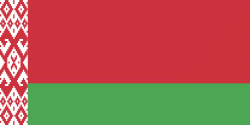Svislach
Svislach or Śvislač (Свiслач, ; Сви́слочь; Świsłocz; סיסלעוויטש or Sislevitch; Svisločius) is a town in the South-West of Grodno Region, Belarus, an administrative center of the Svislach district.
It is connected with Vaŭkavysk by a railroad branch and with Grodno by a highway. International phone number prefix: 375-15-13.
Within the Grand Duchy of Lithuania, Svislach was part of Nowogródek Voivodeship. In 1795, Svislach was acquired by the Russian Empire in the course of the Third Partition of Poland.
In 1927, Rabbi Chaim Yaakov Mishkinsky, whose wife Chaya was the granddaughter of Rabbi Naftali Hertz Halperin of Bialystok, was appointed the rabbi of Svislach. He led the community until the Nazis entered in November 1942 murdering the entire Jewish community. Prior to the war, Rabbi Mishkinsky sent his sons and to Israel (Palestine). Rabbi Mishkinsky's great-granddaughter, Batya Friedman, serves as rebbetzin of Hampstead Garden Suburb Synagogue, London. His great-grandson is Rabbi Yochanan Ivry of Congregation Toras Emes of Staten Island, New York.
Svislach was part of the Second Polish Republic from 1921 until 1939. In September 1939, Svislach was occupied by the Red Army and, on 14 November 1939, incorporated into the Byelorussian SSR. In 1939, there were around 3,000 Jews living in Svislach, along with refugees from western Poland who had settled there after the invasion of Poland. From June 1941 until 17 July 1944, Svislach was occupied by Nazi Germany and administered as a part of Bezirk Bialystok. In July 1941, a ghetto was established in the old Jewish neighbourhood, in the northwest of Svislach. In that area, Jews were also gathered from the village of Golobudy. It was an open ghetto, and the western border of the ghetto's territory ran near the Svislach River. On November 2, 1942, the ghetto was liquidated when the Jews were sent by train to the Vawkavysk transit camp where many massacres occurred. The remaining Jews, mostly elderly and sick, were killed in the Visnik Forest, just outside Svislach.
It is connected with Vaŭkavysk by a railroad branch and with Grodno by a highway. International phone number prefix: 375-15-13.
Within the Grand Duchy of Lithuania, Svislach was part of Nowogródek Voivodeship. In 1795, Svislach was acquired by the Russian Empire in the course of the Third Partition of Poland.
In 1927, Rabbi Chaim Yaakov Mishkinsky, whose wife Chaya was the granddaughter of Rabbi Naftali Hertz Halperin of Bialystok, was appointed the rabbi of Svislach. He led the community until the Nazis entered in November 1942 murdering the entire Jewish community. Prior to the war, Rabbi Mishkinsky sent his sons and to Israel (Palestine). Rabbi Mishkinsky's great-granddaughter, Batya Friedman, serves as rebbetzin of Hampstead Garden Suburb Synagogue, London. His great-grandson is Rabbi Yochanan Ivry of Congregation Toras Emes of Staten Island, New York.
Svislach was part of the Second Polish Republic from 1921 until 1939. In September 1939, Svislach was occupied by the Red Army and, on 14 November 1939, incorporated into the Byelorussian SSR. In 1939, there were around 3,000 Jews living in Svislach, along with refugees from western Poland who had settled there after the invasion of Poland. From June 1941 until 17 July 1944, Svislach was occupied by Nazi Germany and administered as a part of Bezirk Bialystok. In July 1941, a ghetto was established in the old Jewish neighbourhood, in the northwest of Svislach. In that area, Jews were also gathered from the village of Golobudy. It was an open ghetto, and the western border of the ghetto's territory ran near the Svislach River. On November 2, 1942, the ghetto was liquidated when the Jews were sent by train to the Vawkavysk transit camp where many massacres occurred. The remaining Jews, mostly elderly and sick, were killed in the Visnik Forest, just outside Svislach.
Map - Svislach
Map
Country - Belarus
 |
 |
| Flag of Belarus | |
Until the 20th century, different states at various times controlled the lands of modern-day Belarus, including Kievan Rus', the Principality of Polotsk, the Grand Duchy of Lithuania, the Polish–Lithuanian Commonwealth, and the Russian Empire. In the aftermath of the Russian Revolution in 1917, different states arose competing for legitimacy amid the Civil War, ultimately ending in the rise of the Byelorussian SSR, which became a founding constituent republic of the Soviet Union in 1922. After the Polish-Soviet War, Belarus lost almost half of its territory to Poland. Much of the borders of Belarus took their modern shape in 1939, when some lands of the Second Polish Republic were reintegrated into it after the Soviet invasion of Poland, and were finalized after World War II. During World War II, military operations devastated Belarus, which lost about a quarter of its population and half of its economic resources. The republic was redeveloped in the post-war years. In 1945, the Byelorussian SSR became a founding member of the United Nations, along with the Soviet Union.
Currency / Language
| ISO | Currency | Symbol | Significant figures |
|---|---|---|---|
| BYN | Belarusian ruble | Br | 2 |
| ISO | Language |
|---|---|
| BE | Belarusian language |
| RU | Russian language |















